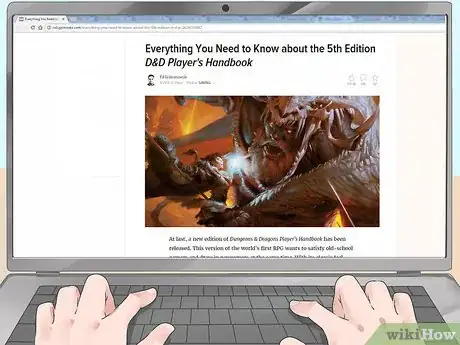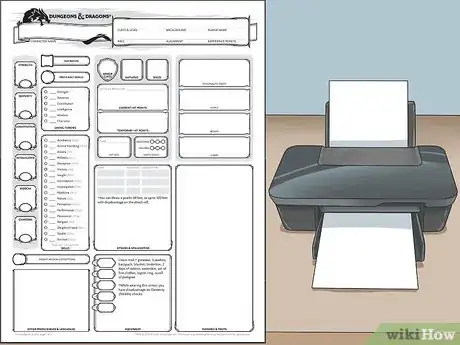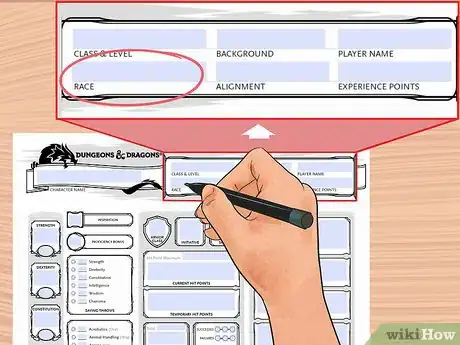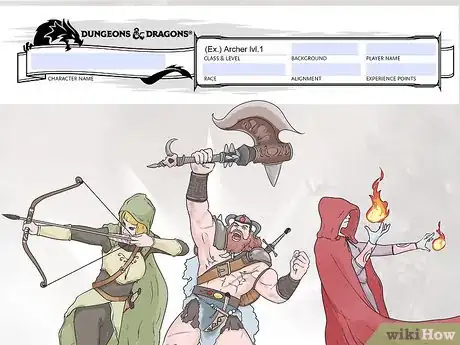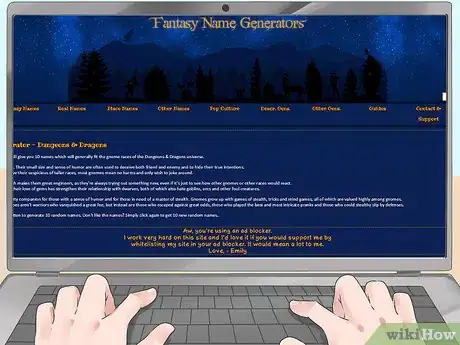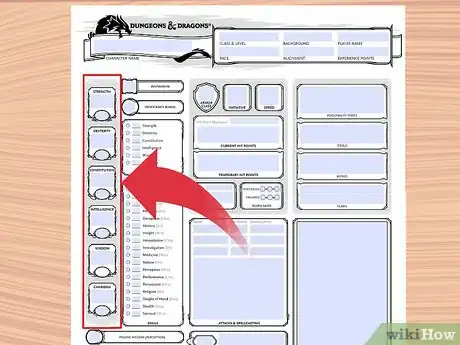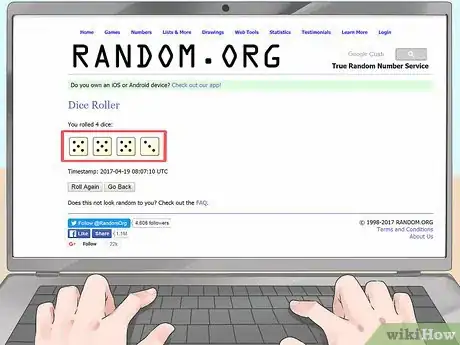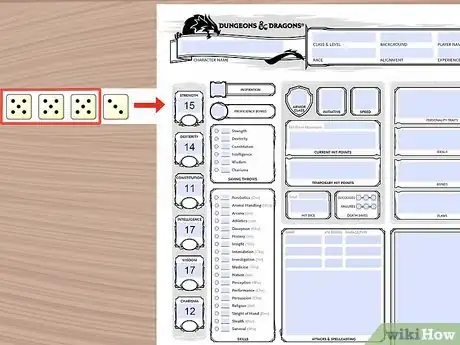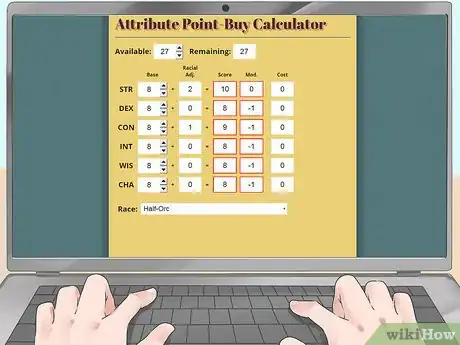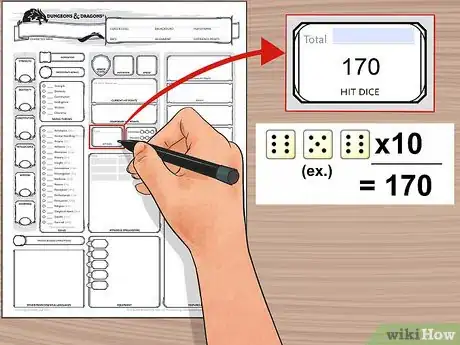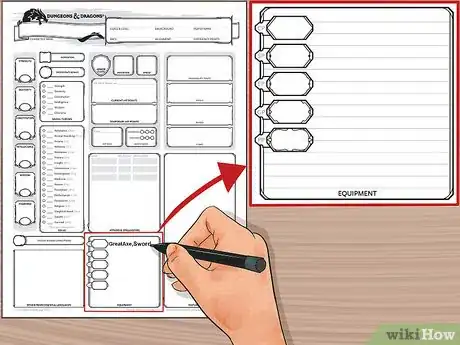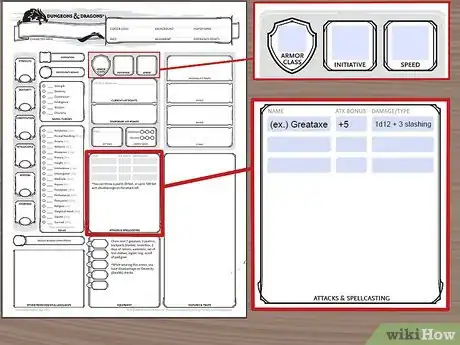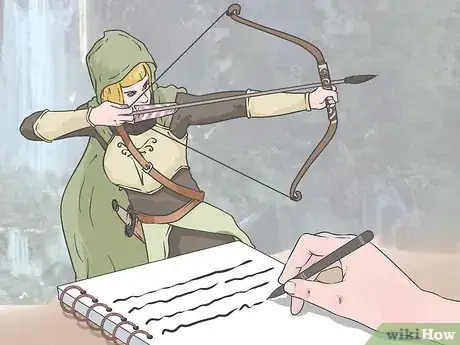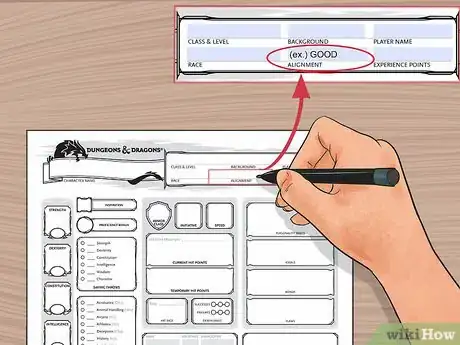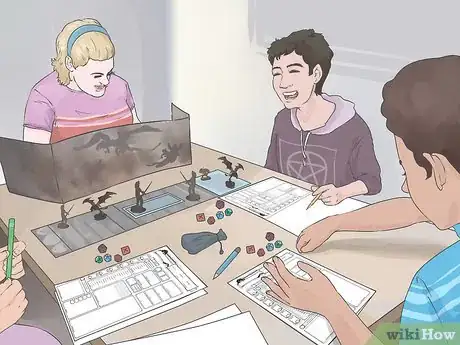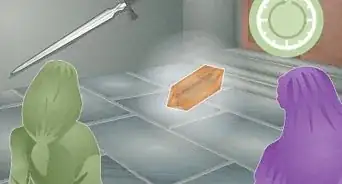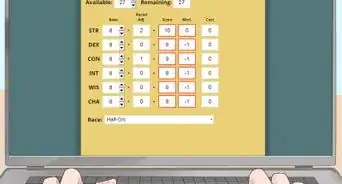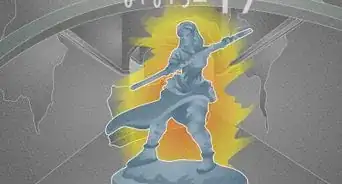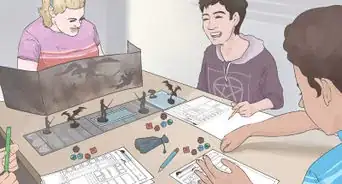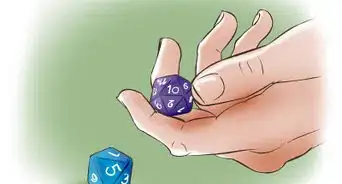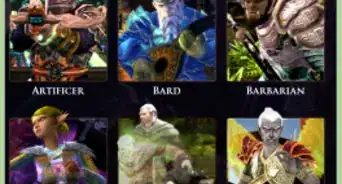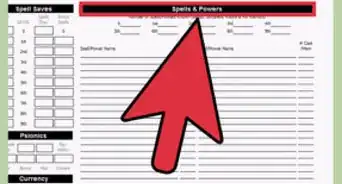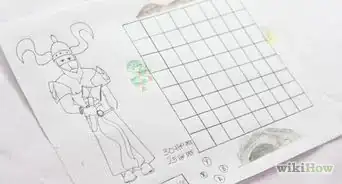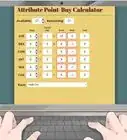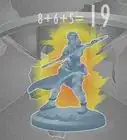This article was co-authored by wikiHow Staff. Our trained team of editors and researchers validate articles for accuracy and comprehensiveness. wikiHow's Content Management Team carefully monitors the work from our editorial staff to ensure that each article is backed by trusted research and meets our high quality standards.
There are 14 references cited in this article, which can be found at the bottom of the page.
This article has been viewed 833,805 times.
Learn more...
Dungeons & Dragons, also known as D&D, is a tabletop role-playing game. You and your friends create unique, fantastical characters to play this game. But before you play, you'll need to establish the basics for your character, like gender, race, and class. Then you can calculate ability scores to determine your character's basic stats, like Strength and Wisdom. After that, you'll equip your character with skills, feats, weapons, and armor. Finish your character up by developing their personality and choosing their alignment, then you're ready to play.
Steps
Establishing the Basics
-
1Verify your D&D edition. As time has passed, TSR and Wizards of the Coast has created multiple editions of D&D, and each edition acts as a sort of "reboot" for the series. There are many different editions of D&D being in circulation, with some editions considered superior to others. The various editions are incompatible with one another, meaning you must verify that you're actually playing a V3.5 D&D game. You and those you’re playing with should all use a single version when making characters or playing a campaign.
- Create a Dungeons and Dragons 5e Character has a guide on how to create a character for the 2014 fifth edition of Dungeons & Dragons.
- Many online resources can be found for various versions of D&D. Find the core rulebooks of versions by doing an online keyword search for them, as in, “D&D 3.5e core rulebook.”[1]
-
2Print a character sheet, if desired. A character sheet will lay out all the information you’ll need to create a character in an orderly fashion. However, you could always write out your character information by hand on a blank sheet of paper, or type it up on a computer.
- Free character sheets can be found online. Do a keyword search for “dungeons and dragons 3.5e character sheets” to find and print one of your own.[2]
- Example character sheets can be found on the D&D Wizards of the Coast website. Use these for inspiration or to check your work.[3]
- Digital character sheets can help you keep track of your characters on digital devices, like phones and tablets.
Advertisement -
3Select a gender and race. Your character will be either male or female. Once you’ve determined gender, you’ll need to choose a race. There are seven basic races, though some players may allow other races to be used. Each race has certain unique characteristics, abilities, strengths, and weaknesses. The seven basic races are:[4]
- Dwarves. Short, stocky, stern, and strong. They have a connection to the earth and often live in mountains or underground lands. Stat modifiers: +2 Constitution, -2 Charisma
- Elves. Tall, long-lived, aloof, and connected to nature. Elves live in harmony with the natural world around them. Stat modifiers: +2 Dexterity, -2 Constitution
- Gnomes. Mysterious, adventure-seeking, and strange. Gnomes are the smallest common race. Stat modifiers: +2 Constitution, -2 Strength
- Half-elves. Solitary, long-lived, graceful, and hearty. Half-elves are few in number, and tend to be wanderers due to their lack of homeland. No stat modifiers.
- Half-orcs. Independent, strong, and distrusted. Half-orcs are considered monstrosities by common folk. They are tall and powerfully built. Stat modifiers: +2 Strength, -2 Intelligence, -2 Charisma
- Halflings. Optimistic, cheerful, curious, and small in stature. On average, only 3 ft (.9 m) tall, they are agile but physically weak. Stat modifiers: +2 Dexterity, -2 Strength.
- Humans. Adaptive, ambitious, and well-balanced. Humans are the dominant race, and are diverse in appearance and culture. No stat modifiers.
-
4Choose a class. A character’s class is like their profession. If your character is starting from scratch at level one, you’ll also be level one in your class. As your character completes adventures, they’ll gain experience points (XP), which are used to raise your level and earn abilities and powers. There are 11 basic classes:
- Barbarian. Uncivilized and strong. Considered brutal berserkers.
- Bard. Charismatic and crafty. Bards use skills and spells to help and harm.
- Cleric. A firm believer in a deity. Clerics heal, raise the dead, and direct the wrath of god.
- Druid. At one with nature. Druids cast spells, interact with animals, and shapeshift into animals and plants.
- Fighter. Firm and brave. Fighters are capable with weapons and comfortable in armor.
- Monk. Martial masters. Monks train their minds and bodies for offense and defense.
- Paladin. Followers of what is good and just. Paladins are devoted knights.
- Ranger. Masters of woodcraft and wildlife. Rangers track and hunt foes.
- Rogue. Stealthy assassins. Rogues are cunning thieves and able scouts.
- Sorcerer. Natural born spellcasters. Sorcerers command strange, ancient energies.
- Wizard. Lifelong magic students. Years of study allow wizards to use awesome magic power.[5]
-
5Name your character. You might want a name that represents your class, like Jafar might for an evil wizard. In classic D&D, different races have names that reflect their culture and native language. Free name pools and generators can be found online with a search for the race, as in “gnome forgotten realms name generator” or “dungeons & dragons dwarf name pool.”[6]
- Use name generators to get a feel for the kinds of names in your character’s race and come up with your own. Cycle through many names with the generator until you find one that suits your character.
- Borrow names from your favorite video game, book, and comic characters. Use the name of your favorite historical figure.
Calculating Ability Scores
-
1Identify the main attributes of your character. Every character is made up of six essential attributes. These are given scores, with high scores reflecting positive bonuses from that attribute and low scores penalties. A score of 10 in any attribute is considered to be average. The six attributes are:
- Strength (Str). A measure of physical power. Important for combat characters, like fighters, monks, and paladins. Strength also dictates how much weight you can carry.
- Dexterity (Dex). A measure of agility. This includes balance and reflexes. Important for rogues, light- to medium-armor wearing characters, and ranged attackers (like bow and sling users).
- Constitution (Cons). A measure of health and fortitude. Constitution increases your character’s hit points, which if depleted, can result in fainting or death.
- Intelligence (Int). A measure of knowledge. Important for wizards and classes requiring reason or learning, like paladins.
- Wisdom (Wis). A measure of correct judgement. Wisdom contributes to common sense, awareness, and willpower. Important for clerics, druids, and rangers.
- Charisma (Cha). A measure of magnetism. High charisma improves likability, appearance, and leadership ability. Important for bards, paladins, and sorcerers.[7]
-
2Roll for ability scores. You’ll need either four six-sided dice (4d6) or an online dice roller to do this. Online dice rollers can be found with a keyword search for “dice roller.” Roll all four dice. Add the three highest dice together and record this number. Repeat this until you have six recorded numbers.[8]
-
3Assign the six recorded numbers to the six main attributes. You can assign your recorded numbers any way you choose, but you’ll likely want to assign strong scores to attributes that are valuable to your class. Remember to add your racial stat modifiers to your total attribute scores.
-
4Generate random ability scores online. There are ability score generators you can find and use online with a keyword search for “ability score generator.”
- To provide an example of a racial stat bonus: after rolling your ability scores, if you were a human, you’d get +2 points for any one attribute.
- Use less dice when rolling ability scores to increase the difficulty of your D&D experience. 3d6 is often called “classic,” and only using 2d6 is termed “heroic.”
-
5Record the modifier for each ability. The ability modifier is the bonus or penalty each ability score gives your character. For example, an ability score of 10 or 11 is average, so it has no bonuses or penalties (+0).
- Modifier bonuses or penalties are added or subtracted to any activity requiring one of these main attributes.
- Modifiers can also grant additional spells per day in an ability, if applicable. The following list provides some ability scores followed by their modifiers:
- Score / Modifier
- 2 – 3 / -4
- 4 – 5 / -3
- 6 – 7 / -2
- 8 – 9 / -1
- 10 – 11 / +0
- 12 – 13 / +1
- 14 – 15 / +2
- 16 – 17 / +3
- 18 – 19 / +4
- 20 – 21 / +5[9]
Equipping Skills, Feats, Weapons, and Armor
-
1Select skills for your character. Skills are important basic abilities. You’ll find an extensive list of these on character sheets, including things like Acrobatics, Climb, Knowledge (history), Linguistics, Stealth, and more. Skills are earned by gaining levels, acquired by accumulating XP.
- With each new level, your character gets skill ranks which are invested into specific skills, like Bluff, Sleight of Hand, or Swim. The amount of skill points for investing in skill ranks is higher for characters with higher intelligence.
- Characters receive an automatic +3 bonus to class skills with at least one skill rank. These favored skills should be listed along with your character’s class description.
- Your rank in a skill cannot be higher than the combined total of your character level and three.[10]
-
2List your character’s feats. Your character’s feats refer to abilities that aren’t linked to their race, class, or skills. These include things like dodging reflex, a knack for fighting with bladed weapons, and natural skill with crafting items. Some feats have restrictions, like a minimum ability score or level. Many feats are oriented at improving class abilities or lessening class penalties.
-
3Roll for your starting gold. Gold (GP), which is the currency of D&D, is usually awarded for completing quests and defeating enemies. However, each character starts with a pre-determined amount. This amount depends on your character’s class. Calculate your starting GP by calculating:
- Barbarian, 3d6 x 10 GP
- Bard, 3d6 x 10 GP
- Cleric, 4d6 x 10 GP
- Druid, 2d6 x 10 GP
- Fighter, 5d6 x 10 GP
- Monk, 1d6 x 10 GP
- Paladin, 5d6 x 10 GP
- Ranger, 5d6 x 10 GP
- Rogue, 4d6 x 10 GP
- Sorcerer, 2d6 x 10 GP
- Wizard, 2d6 x 10 GP[11]
-
4Equip your character with items. Use gold to buy the starting weapons, armor, items (potions, torches), and equipment (tents, rope) for your character. Lists of items, weapons, and armor can be found online. In some games, you may only have simple weapons or armor available until you find a suitable shop where you can buy better ones.
- Characters that are suited for the center of the action, like fighters and paladins, will likely need heavy armor, like plate mail and a shield, along with a weapon, like a broadsword or mace.
- Characters that are agility based, like gnomes, rogues, and rangers, are better suited to light armor, like chainmail or boiled leather, and distance or sneak attack weapons, like a bow, sling, or a Kukri knife.
- Frail characters, like many wizards and bards, may only be able to equip very light armor or robes. Weapons, too, are usually limited to light varieties, like rods, staves, bows, and whips.[12]
-
5Fill in armor class and combat bonuses. Weapon and armor bonuses will be listed along with the weapon and armor information. In some cases, like with very heavy weapons/armor, there may also be penalties. A high armor class (AC) will make your character more resistant to damage. Attack bonuses help you land damaging hits.
- Use the following calculations to determine your AC and attack bonuses:
- AC = 10 + armor bonus + shield bonus + Dexterity Modifier + other modifiers (like racial or class)
- Melee attack bonus = base attack bonus + Strength Modifier + size modifier
- Ranged attack bonus = base attack bonus + Dexterity Modifier + size modifier + range penalty (if any)
- Size modifiers are determined according to the following scale: Colossal (-8), Gargantuan (-4), Huge (-2), Large (-1), Medium (+0), Small (+1), Tiny (+2), Diminutive (+4), Fine (+8). Small characters are generally more agile, whereas large ones are generally strong. Larger characters can also carry larger and heavier objects.[13]
- Use the following calculations to determine your AC and attack bonuses:
Finishing Your Character
-
1Paint a picture of your character. Feel free to do this in a drawing or with words. Include basic physical features like age, weight, height, skin color, and more. Think of your character’s personality, which will influence the decisions they make in the game.
- Write a backstory for your character. What was their young life like? This will give you a better sense of the character as separate from yourself, which will help with role-playing later.
- Goals, fears, and desires can add depth to your character. Keep these in mind as you play your character and interact with other players and non-player characters (NPCs).
-
2Determine the alignment of your character. Alignment is a measure of moral attitude. There are nine basic alignments which encompass a range of personalities, philosophies, and beliefs. Alignment consists of one order characteristic (Lawful, Neutral, Chaotic) and one moral characteristic (Good, Neutral, Evil), as in lawful-neutral, lawful-evil, neutral-good, and chaotic-good.
- Good characters are driven to protect innocence and life. Good sacrifices for others and cares for the dignity of sentient creatures.
- Evil characters undermine or harm life. Evil hurts, harms, and oppresses, usually for fun or personal gain.
- Morally neutral characters avoid killing, but usually lack a sense of obligation to sacrifice for or protect others.
- Lawful characters respect order, truth, authority, and tradition. They are often closed-minded, overly rigid, and self-righteous.
- Chaotic characters make decisions according to their conscience. They resent authority and love freedom, though they can be reckless and irresponsible.
- Order neutral characters are generally honest, but susceptible to temptation. They feel neither a need to obey orders or rebel.[14]
-
3Play your character in a campaign. Join other players so you can play your character in a campaign decided or created by your dungeon master. Sample campaigns and resources can be found online, but so long as you have access to a core rulebook, you can create your own D&D world.
- For those who are brand new to D&D, dungeon masters are the coordinators of the game. They describe setting, control non-player characters, and design dungeons for characters to overcome.
Community Q&A
-
QuestionHow do you roll for your starting Hit Points? Every time I create a character I can never find a straight answer. Is it rolling my hit dice (1d6 in this case) plus my CON modifier?
 Community AnswerFor your first level, you don't roll a hit die. If your hit die is a d6, your starting hit points are equal to the highest possible roll (in this case 6) + your con modifier. At level two and beyond, you roll your hit die, add your con modifier, then add that to your total hit points.
Community AnswerFor your first level, you don't roll a hit die. If your hit die is a d6, your starting hit points are equal to the highest possible roll (in this case 6) + your con modifier. At level two and beyond, you roll your hit die, add your con modifier, then add that to your total hit points. -
QuestionWhy do we need such complicated dice?
 Community AnswerAll of the dice play different roles. Different weapon types do different damage, percentages and statistic rolls need to be made at different points in the game, and different dice are rolled for hit points upon level gain, depending on character type.
Community AnswerAll of the dice play different roles. Different weapon types do different damage, percentages and statistic rolls need to be made at different points in the game, and different dice are rolled for hit points upon level gain, depending on character type. -
QuestionCan a character that has already died be reused in another Dungeons and Dragons game?
 Community AnswerSure! A character that has died could be used in a different campaign. The character could even be resurrected within the same campaign.
Community AnswerSure! A character that has died could be used in a different campaign. The character could even be resurrected within the same campaign.
Warnings
- Many character choices can be permanent so make choices carefully.⧼thumbs_response⧽
References
- ↑ https://www.d20srd.org/index.htm
- ↑ http://archive.wizards.com/default.asp?x=dnd/dnd/charactersheets
- ↑ http://media.wizards.com/downloads/dnd/StarterSet_Charactersv2.pdf
- ↑ https://www.d20srd.org/srd/races.htm
- ↑ https://www.d20srd.org/indexes/classes.htm
- ↑ https://www.wizards.com/dnd/article5.asp?x=dnd/dx20010202b
- ↑ http://www.d20srd.org/srd/theBasics.htm#abilityScores
- ↑ http://www.d20srd.org/srd/theBasics.htm
- ↑ https://www.d20srd.org/srd/theBasics.htm#abilityModifier
About This Article
To create a Dungeons and Dragons character, start by deciding on a gender and race for your character, like a female dwarf or a male halfling. You should also choose a class for your character, like bard, druid, or wizard. Next, come up with a name for your character, or use an online name generator to find one you like. Once you've established the basics, identify your character's main attributes and roll for their ability scores. Finally, equip your character with skills, feats, weapons, and armor. To learn how to start playing with your Dungeons and Dragons character in a campaign, scroll down!
